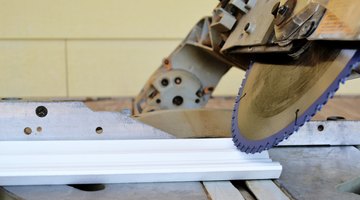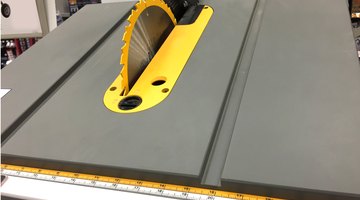What Is a Double-Bevel Miter Saw?
Table of Contents
Standard miter saws have motors (with their blades) that can be rotated to make cuts at a range of miter angles but can cut only straight down, at 90 degrees.

Compound miter saws can rotate and also tilt sideways to cut bevels and angles at the same time -- but the typical compound miter saw tilts only to the left side. If you want to cut an opposing bevel on the other end of the workpiece you have to flip it end for end to make the cut. Double-bevel miter saws are compound saws that tilt to both the right and left so you can bevel in both directions without flipping the workpiece.
The Flipping Issue

Crown molding is a perfect example of when you'd use a double-bevel miter saw. For a 90-degree corner, the miter angle is typically about 31.6 degrees. The bevel or tilt is about 33.9 degrees. The crown molding is placed flat on the fence and cut. Standard single-bevel saws require you to flip the molding 180 degrees and cut the miter on the other end of the molding. Double-bevel miter saws allow you to make the first cut, slide the molding down, tilt the blade to the opposite side, and make the next cut without flipping the piece. This feature is also handy for cutting odd angles on furniture legs, braces and other components.
Angles and Options

Calculating complex angles is another advantage of the double-bevel saw. Most saws have standard preset angles, but presets don't always apply to all situations. For example: The 31.6-degree miter cut and 33.9-degree bevel cut apply to 52/38 crown molding, which is considered standard. Other sizes of crown molding require different settings, which may or may not be referenced by presets. Today's double-bevel compound saws tend to be more advanced and have more options than many standard counterparts, making them more adaptable to complex angles.
Costs and Benefits

The double-bevel saw is more expensive than the single-bevel. A single-bevel miter saw can make the same cuts as a double-bevel; the advantage of a double-bevel saw is convenience and efficiency. If you're thinking of becoming a trim carpenter and plan on installing elaborate architectural millwork, it might be worth spending the extra money on a double-bevel saw. If you're an average DIYer who might tackle crown molding occasionally, a single-bevel model will get the job done.
Look at the Fence

Identify a double-bevel miter saw by its fence. Double-bevel saws have a V-shaped cutout on the fence to accommodate the low angle of the blade on each side. Single-bevel miter saws typically have an angled end on the fence at the left side of the blade only.
Table Saws Too

Table saws are another type with bevel cutting capacity. For many years, table saw blades tilted only to the right. More advanced table saws have blades that tilt to the left and right. Because of the bigger, wider, longer pieces cut on a table saw, the left-right tilting blade is a tremendous advantage and is highly recommended for serious woodworkers.
The Drip Cap
- Standard miter saws have motors (with their blades) that can be rotated to make cuts at a range of miter angles but can cut only straight down, at 90 degrees.
- _ If you want to cut an opposing bevel on the other end of the workpiece you have to flip it end for end to make the cut.
- _ Double-bevel miter saws allow you to make the first cut, slide the molding down, tilt the blade to the opposite side, and make the next cut without flipping the piece**.
- This feature is also handy for cutting odd angles on furniture legs, braces and other components.
- Identify a double-bevel miter saw by its fence**.
- Double-bevel saws have a V-shaped cutout on the fence to accommodate the low angle of the blade on each side.
- For many years, table saw blades tilted only to the right.
- **
References
Writer Bio
Specializing in hardwood furniture, trim carpentry, cabinets, home improvement and architectural millwork, Wade Shaddy has worked in homebuilding since 1972. Shaddy has also worked as a newspaper reporter and writer, and as a contributing writer for Bicycling Magazine. Shaddy began publishing in various magazines in 1992, and published a novel, “Dark Canyon,” in 2008.
Photo Credits
- Melissa Kirk/Demand Media
- Melissa Kirk/Demand Media
- Melissa Kirk/Demand Media
- Melissa Kirk/Demand Media
- Melissa Kirk/Demand Media
- Melissa Kirk/Demand Media
- Melissa Kirk/Demand Media
More Articles



